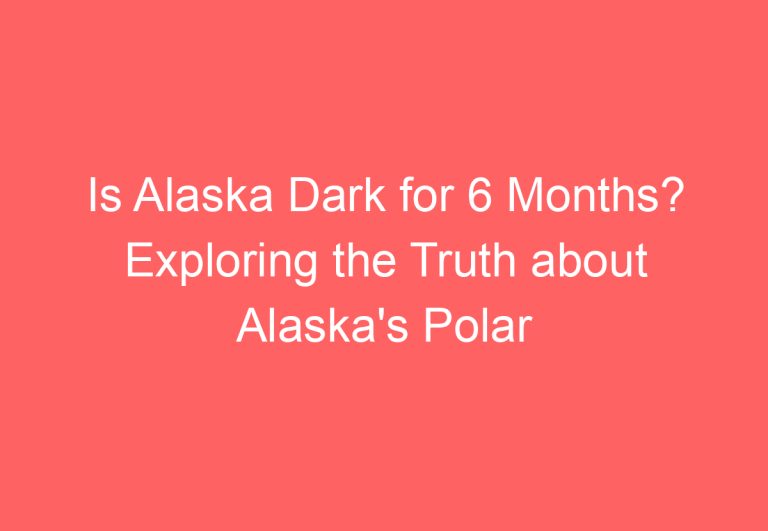Does Alaska Really Have 6 Months of Darkness?
Alaska is often associated with extreme darkness and long nights, leading many to believe that the state experiences six months of darkness every year. However, is this really true? The answer is no – while some parts of Alaska may experience periods of extended darkness, the state as a whole does not have six consecutive months of darkness.

In fact, only the most extreme poles of the earth have a full six months of darkness and six months of light, and no part of Alaska is north enough to experience this phenomenon. Utqiagvik, the northernmost city in Alaska, experiences a “polar night” which is a full two months of darkness without sunlight. However, other parts of the state have varying amounts of daylight throughout the year, depending on their latitude and region.
It’s important to dispel this myth about Alaska’s darkness, as it can deter potential visitors from experiencing the state’s unique beauty and culture. While some areas may have longer periods of darkness than others, there are also times of the year where the state experiences almost 24 hours of daylight. Understanding the truth about Alaska’s daylight and darkness can help visitors plan their trips accordingly and fully appreciate all that the state has to offer.
Understanding Alaska’s Daylight Variations

Alaska is known for its extreme daylight variations throughout the year. While the popular belief is that Alaska experiences six months of darkness, this is not entirely true. The amount of daylight and darkness varies depending on the location and time of year. In this section, we will explore the geographic influence on daylight and the phenomenon of polar night and midnight sun.
Geographic Influence on Daylight
Alaska’s latitude plays a significant role in its daylight variations. The state is located in the northern hemisphere, and the Arctic Circle passes through its northern region. The latitude of a place determines the angle at which the sun’s rays hit the earth’s surface. As a result, the higher the latitude, the lower the angle, and the less direct sunlight a place receives.
During the summer solstice, which occurs around June 21st, Alaska experiences 24-hour daylight in its northern region. On the other hand, during the winter solstice, which occurs around December 21st, the northern region of Alaska experiences 24-hour darkness. The farther south you go, the less extreme the variations become.
The Phenomenon of Polar Night and Midnight Sun
The polar night and midnight sun are two natural phenomena that occur in Alaska. The polar night is a period of complete darkness that occurs in the winter months. It occurs in regions located north of the Arctic Circle, including the northernmost city of Utqiagvik. During this period, the sun does not rise above the horizon for at least 24 hours.
The midnight sun, on the other hand, is a period of 24-hour daylight that occurs during the summer months. It occurs in regions located north of the Arctic Circle, including the northernmost city of Utqiagvik. During this period, the sun does not set below the horizon for at least 24 hours.
In conclusion, Alaska’s daylight variations are influenced by its latitude and geographic location. While the state does not experience six months of uninterrupted darkness, it does experience periods of polar night and midnight sun. Understanding these phenomena is essential for planning a visit to Alaska and experiencing its unique natural beauty.
Effects of Extended Darkness and Light

Impact on Residents and Wildlife
Alaska is known for its extended periods of darkness and light, which can have a significant impact on both residents and wildlife. During the winter months, Alaskans experience shorter days and longer nights, which can lead to seasonal affective disorder (SAD) in some individuals. SAD is a type of depression that is caused by a lack of sunlight and can result in feelings of sadness, hopelessness, and fatigue.
Wildlife in Alaska also experiences the effects of extended darkness and light. During the winter months, many animals go into hibernation or migrate to warmer climates to avoid the harsh weather conditions. However, some animals, such as polar bears and arctic foxes, have adapted to the extreme conditions and are able to survive in the harsh environment.
Adaptation and Activities During Extremes
Despite the challenges posed by the extended periods of darkness and light in Alaska, residents have found ways to adapt and thrive in the extreme environment. For example, many Alaskans use blackout curtains to block out the light during the summer months, allowing them to get a good night’s sleep. Others use light therapy to combat the effects of SAD, which involves exposure to bright light for a set amount of time each day.
In addition, outdoor activities are a popular way for Alaskans to stay active and enjoy the unique environment. During the winter months, activities such as skiing, snowboarding, and snowmobiling are popular, while during the summer months, hiking, fishing, and camping are common.
Energy is also a concern in Alaska during the winter months when there is less sunlight. Many residents rely on alternative sources of energy such as wind and solar power to supplement their energy needs. Overall, while the extended periods of darkness and light in Alaska can be disorienting, residents and wildlife have found ways to adapt and thrive in the unique environment.
Frequently Asked Questions

What months of the year is it dark in Alaska?
In Alaska, the amount of daylight and darkness varies greatly depending on the location within the state. While some parts of Alaska experience periods of extended darkness, particularly during the winter months, the state as a whole does not experience six months of uninterrupted darkness. Generally, the period of darkness starts from late November and lasts until late January.
When does Alaska experience 24 hours of darkness?
Only the most extreme poles of the earth have a full six months of darkness and six months of light, and no part of Alaska is north enough to experience this phenomenon. However, the northernmost city of Utqiagvik experiences a “polar night,” which is a full two months of darkness without sunlight. This period usually occurs from mid-November to mid-January.
How long does the period of darkness last in Alaska?
The period of darkness in Alaska varies depending on the location within the state. In general, the period of darkness lasts for about two months in the northernmost city of Utqiagvik, while other parts of the state may experience shorter periods of darkness during the winter months.
What is the duration of the longest day in Alaska?
During the peak of summer, Alaska experiences long summer days when the sun barely sets. The northernmost city of Utqiagvik experiences 24-hour daylight for 82 days straight. Other parts of the state may also experience long days during the summer months, but the duration varies depending on the location.
Does Anchorage ever experience complete darkness for 24 hours?
Anchorage, the largest city in Alaska, does not experience complete darkness for 24 hours. However, during the winter months, the city experiences shorter periods of daylight and longer periods of darkness.
Why is there an extended period of night in Alaska?
The extended period of darkness in Alaska is due to its location in the far north, close to the Arctic Circle. During the winter months, the tilt of the earth’s axis causes the northern hemisphere to be tilted away from the sun, resulting in shorter days and longer nights. The opposite occurs during the summer months, resulting in longer days and shorter nights.






